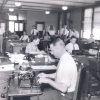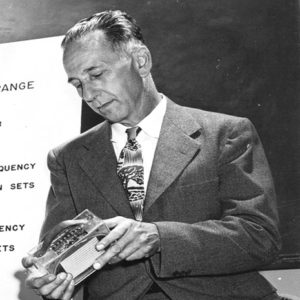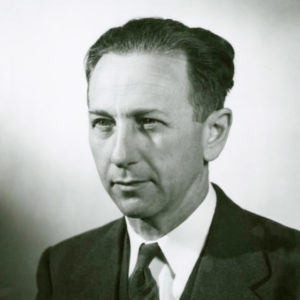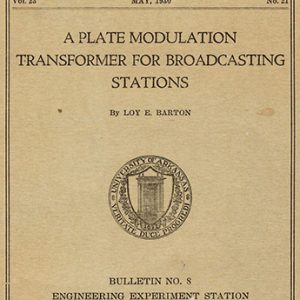calsfoundation@cals.org
Loy Barton (1897–1986)
Loy Edgar Barton was a prolific pioneer in the field of radio and television engineering. He was awarded a number of U.S. patents and was responsible for significant technical inventions in radio and television technology.
Loy Barton was born on November 7, 1897, to Henry Barton and Mary Frances Barton in Washington County, Arkansas, and spent his early life there. He displayed an early interest in machinery and the relatively new fields of electricity and “wireless” transmission, leading to his enrollment in the engineering program at the University of Arkansas (UA) in Fayetteville (Washington County). He received an undergraduate degree there and began teaching engineering courses at the school. During this period, Barton elected to pursue advanced engineering studies and, in 1924, was assigned an unusual hands-on thesis project. The university had been an early entrant in the 1920s radio broadcasting boom, securing a license for a commercial radio station in 1923 and hiring an Oklahoma firm to construct and install a 100-watt transmitter. The newly constructed station performed poorly, and rather than task another outside entity with design and fabrication of a “second-generation” radio station, the administration turned to the engineering college. Barton, assisted by another instructor, H. W. McKinley, was given the assignment.
An important area of AM (amplitude modulation) radio is in impressing speech and music on what is referred to as a “carrier wave,” which serves as a pathway from transmitter to receiver. (The carrier wave is silent, conveying no information whatsoever. It is only by the addition of audio frequencies to the carrier wave that broadcasting is possible.) Barton’s 1925 thesis indicates that the modulation process was foremost in his thoughts when designing the station’s new transmitter. He utilized what was then state-of-the-art modulation technology (Heising), but he was aware of its limitations and inefficiencies; he described these in detail in his thesis.
Barton realized that a fairly simple circuit change would greatly improve the modulation process while at the same time improving operating efficiency. However, as he noted in the thesis: “the writer will not have the time to test or try the idea.” Barton and his wife, Edith Barton, by that time had a young child, and he was likely having trouble making ends meet as a part-time instructor. He likely wished to complete his studies as quickly as possible, enter the engineering workforce, and begin receiving a livable salary.
The transmitter that Barton designed for station KFMQ (later KUOA) was an overwhelming success. He was soon awarded his degree and left Arkansas to pursue a career with the General Electric Company in Schenectady, New York. After only a few years with GE, he was lured back to Fayetteville by the offer of a faculty position at the university.
Barton resurrected his idea for improving transmitter modulation and obtained funding for the custom-built transformer needed for the scheme. He added his new circuit to the KUOA transmitter and found that it performed even better than expected. In May 1930, Barton published a description of the project in the school’s Bulletin, an obscure journal more commonly devoted to communicating techniques for boosting crop yields and other agricultural information. His paper ultimately came to the attention of the Radio Corporation of America (RCA), where the modulation improvement technique was considered to be of such importance that Barton was hired away from the university to work in RCA’s Camden, New Jersey, broadcast equipment division. It was there that he patented his development and assigned rights to RCA. From the 1930s on, the company incorporated Barton’s invention in nearly all its AM transmitter products. (RCA also licensed the technology to a number of other manufacturers.) The modulation process—technically known as high-level “Class B” plate modulation—soon became the dominant form of modulation in AM radio transmitters globally and remained in widespread use until more efficient technologies were developed in the 1970s. Barton was also an early proponent of the transistor when it emerged from the laboratory in the late 1940s, and he designed and built several prototype portable radios based on the new solid-state device.
Barton continued to invent throughout his career, amassing a number of patents in the field of electronics. One of these played a role in color television equal in significance to his transmitter modulation scheme. RCA launched a program in the early 1950s to develop a color TV system, and Barton and another RCA engineer, Peter Werenfels, worked together to solve a particularly perplexing problem—keeping color in home receivers synchronized with that originating from studio cameras. The solution was transmission of a short “burst” of reference information embedded in the portion of the signal being used to keep the camera and receiver scanning in step with each other. The color burst principle became an integral part of the National Television System Committee (NTSC) color TV system when it debuted in the United States in 1953, and was also incorporated in a color system (PAL, or “phase alternating line”) used in Europe and elsewhere. The NTSC system remained in widespread use in the United States until the 2009 Federal Communications Commission–mandated conversion of most TV stations to digital operation.
Barton remained an active inventor even after his retirement from RCA, working with Abram Spanel (founder of the company that became Playtex) in the design of machinery for textile manufacturing. He received patents in this field also.
Barton eventually moved from New Jersey to Florida, where he died of cancer on November 23, 1986. His remains are interred in Fairview Memorial Gardens in Fayetteville.
For additional information:
Barton, Loy Edgar. “The Design, Construction, and Operation of the 500-Watt Broadcasting Station of the University of Arkansas.” MA Thesis, University of Arkansas, 1925.
Loy E. Barton Materials. Special Collections. University of Arkansas Library, Fayetteville, Arkansas. Finding aid online at http://libraries.uark.edu/specialcollections/findingaids/ead/transform.asp?xml=mc1849&xsl=findingaid#idm1322822541 (accessed September 8, 2020).
O’Neal, James. “Loy Barton, a Forgotten Radio Pioneer.” Radio World. http://www.radioworld.com/article/loy-barton-a-forgotten-radio-pioneer/18284 (accessed September 8, 2020).
Poindexter, Ray. Arkansas Airwaves. North Little Rock, AR: 1974.
James E. O’Neal
IEEE Broadcast Technology
 Mass Media
Mass Media Science and Technology
Science and Technology World War II through the Faubus Era, 1941 through 1967
World War II through the Faubus Era, 1941 through 1967 Loy Barton
Loy Barton  Loy Barton
Loy Barton  UA Bulletin
UA Bulletin 




Comments
No comments on this entry yet.